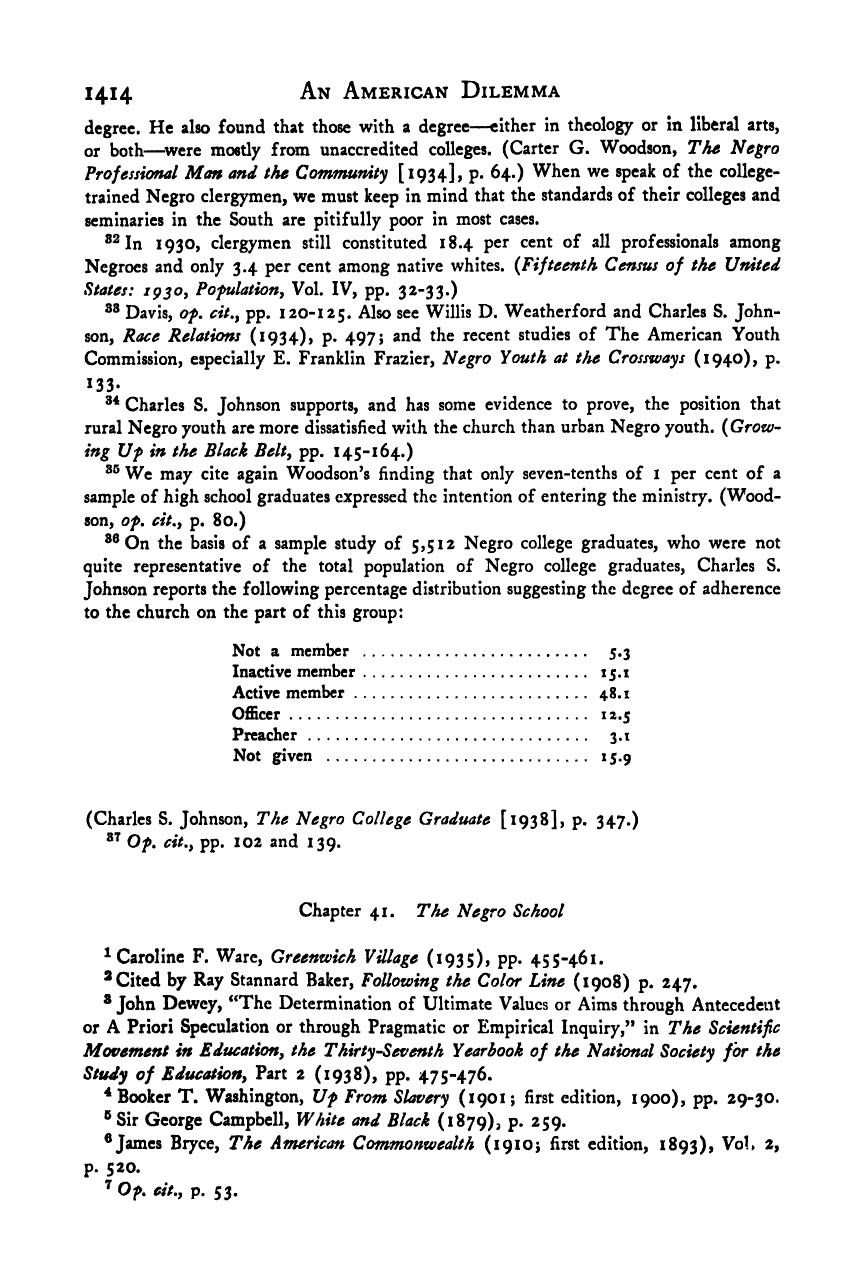Note: Gunnar Myrdal died in 1987, less than 70 years ago. Therefore, this work is protected by copyright, restricting your legal rights to reproduce it. However, you are welcome to view it on screen, as you do now. Read more about copyright.
Full resolution (TIFF) - On this page / på denna sida - Footnotes - Chapter 40 - Chapter 41

<< prev. page << föreg. sida << >> nästa sida >> next page >>
Below is the raw OCR text
from the above scanned image.
Do you see an error? Proofread the page now!
Här nedan syns maskintolkade texten från faksimilbilden ovan.
Ser du något fel? Korrekturläs sidan nu!
This page has never been proofread. / Denna sida har aldrig korrekturlästs.
1414 An American Dilemma
degree. He also found that those with a degree—either in theology or in liberal arts,
or both—^were mostly from unaccredited colleges. (Carter G. Woodson, The Negro
Professional Man and the Community [i934]> p. 64.) When we speak of the college-
trained Negro clergymen, we must keep in mind that the standards of their colleges and
seminaries in the South are pitifully poor in most cases.
*^In 1930, clergymen still constituted 18.4 per cent of all professionals among
Negroes and only 3.4 per cent among native whites. {Fifteenth Census of the United
States: 1930^ Popilation, Vol. IV, pp. 32-33.)
Davis, Of. cit.^ pp. 1 20-1 25. Also see Willis D. Weatherford and Charles S. John-
son, Race Relations (1934), p. 497; and the recent studies of The American Youth
Commission, especially E. Franklin Frazier, Negro Youth at the Crossways (1940), p.
133 -
Charles S. Johnson supports, and has some evidence to prove, the position that
rural Negro youth are more dissatisfied with the church than urban Negro youth. {Grow-
ing Uf in the Black Belt^ pp. 145-164.)
We may cite again Woodson’s finding that only seven-tenths of i per cent of a
sample of high school graduates expressed the intention of entering the ministry. (Wood-
son, of. cit.y p. 80.)
On the basis of a sample study of 5,512 Negro college graduates, who were not
quite representative of the total population of Negro college graduates, Charles S.
Johnson reports the following percentage distribution suggesting the degree of adherence
to the church on the part of this group:
Not a member 5.3
Inactive member 15.1
Active member 48.1
Officer 12.5
Preacher 3.1
Not given 15.9
(Charles S. Johnson, The Negro College Graduate [1938], p. 347.)
Of. cit.y pp. 102 and 139.
Chapter 41. T/ie Negro School
^Caroline F. Ware, Greenwich Village (1935), pp. 455-461.
* Cited by Ray Stannard Baker, Following the Color Line (1908) p. 247,
* John Dewey, “The Determination of Ultimate Values or Aims through Antecedent
or A Priori Speculation or through Pragmatic or Empirical Inquiry,” in The Scientific
Movement in Education, the Thirty-Seventh Yearbook of the National Society for the
Study of Education, Part 2 (1938), pp. 475-476.
^Booker T. Washington, Uf From Slavery (1901; first edition, 1900), pp. 29-30.
® Sir George Campbell, White and Black (1879), p. 259.
® James Bryce, The American Commonwealth (191OJ first edition, 1893),
p. 520.
^ Of. eit., p. 53.
<< prev. page << föreg. sida << >> nästa sida >> next page >>